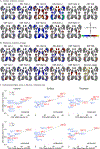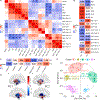Subcortical Brain Alterations in Carriers of Genomic Copy Number Variants
- PMID: 37434504
- PMCID: PMC10885337
- DOI: 10.1176/appi.ajp.20220304
Subcortical Brain Alterations in Carriers of Genomic Copy Number Variants
Abstract
Objective: Copy number variants (CNVs) are well-known genetic pleiotropic risk factors for multiple neurodevelopmental and psychiatric disorders (NPDs), including autism (ASD) and schizophrenia. Little is known about how different CNVs conferring risk for the same condition may affect subcortical brain structures and how these alterations relate to the level of disease risk conferred by CNVs. To fill this gap, the authors investigated gross volume, vertex-level thickness, and surface maps of subcortical structures in 11 CNVs and six NPDs.
Methods: Subcortical structures were characterized using harmonized ENIGMA protocols in 675 CNV carriers (CNVs at 1q21.1, TAR, 13q12.12, 15q11.2, 16p11.2, 16p13.11, and 22q11.2; age range, 6-80 years; 340 males) and 782 control subjects (age range, 6-80 years; 387 males) as well as ENIGMA summary statistics for ASD, schizophrenia, attention deficit hyperactivity disorder, obsessive-compulsive disorder, bipolar disorder, and major depression.
Results: All CNVs showed alterations in at least one subcortical measure. Each structure was affected by at least two CNVs, and the hippocampus and amygdala were affected by five. Shape analyses detected subregional alterations that were averaged out in volume analyses. A common latent dimension was identified, characterized by opposing effects on the hippocampus/amygdala and putamen/pallidum, across CNVs and across NPDs. Effect sizes of CNVs on subcortical volume, thickness, and local surface area were correlated with their previously reported effect sizes on cognition and risk for ASD and schizophrenia.
Conclusions: The findings demonstrate that subcortical alterations associated with CNVs show varying levels of similarities with those associated with neuropsychiatric conditions, as well distinct effects, with some CNVs clustering with adult-onset conditions and others with ASD. These findings provide insight into the long-standing questions of why CNVs at different genomic loci increase the risk for the same NPD and why a single CNV increases the risk for a diverse set of NPDs.
Keywords: Depressive Disorders; Genetics/Genomics; Neurodevelopmental Disorders; Neuroimaging; Schizophrenia Spectrum and Other Psychotic Disorders.
Conflict of interest statement
Dr. van den Bree, Dr. Owen, and Dr. Hall have received grants from Takeda Pharmaceuticals. Dr. Owen has received a grant from Akrivia Health. Dr. Ching and Dr. Thompson have received a research grant from Biogen. Dr. Gutman is employed by and holds stock in Natera. The other authors report no financial relationships with commercial interests.
Figures




Update of
-
Subcortical brain alterations in carriers of genomic copy number variants.medRxiv [Preprint]. 2023 Feb 22:2023.02.14.23285913. doi: 10.1101/2023.02.14.23285913. medRxiv. 2023. Update in: Am J Psychiatry. 2023 Sep 1;180(9):685-698. doi: 10.1176/appi.ajp.20220304. PMID: 36865328 Free PMC article. Updated. Preprint.
References
-
- Levitt JJ, Bobrow L, Lucia D, et al. : A selective review of volumetric and morphometric imaging in schizophrenia. Curr Top Behav Neurosci 2010; 4:243–281 - PubMed
-
- Jacquemont S, Huguet G, Klein M, et al. : Genes To Mental Health (G2MH): A framework to map the combined effects of rare and common variants on dimensions of cognition and psychopathology [Internet]. Am J Psychiatry 2021; [cited 2022 Feb 1] Available from: https://orca.cardiff.ac.uk/144370/ - PMC - PubMed
Publication types
MeSH terms
Grants and funding
- P50 HD105351/HD/NICHD NIH HHS/United States
- R01 MH129858/MH/NIMH NIH HHS/United States
- R01 MH085953/MH/NIMH NIH HHS/United States
- R01 MH116147/MH/NIMH NIH HHS/United States
- 100202/Z/12/Z/WT_/Wellcome Trust/United Kingdom
- U54 EB020403/EB/NIBIB NIH HHS/United States
- U01 MH119739/MH/NIMH NIH HHS/United States
- R01 MH100900/MH/NIMH NIH HHS/United States
- R37 MH085953/MH/NIMH NIH HHS/United States
- R03 MH105808/MH/NIMH NIH HHS/United States
- U01 MH119690/MH/NIMH NIH HHS/United States
- RF1 MH123163/MH/NIMH NIH HHS/United States
- R01 MH121246/MH/NIMH NIH HHS/United States
- WT_/Wellcome Trust/United Kingdom
LinkOut - more resources
Full Text Sources
Medical
Miscellaneous

